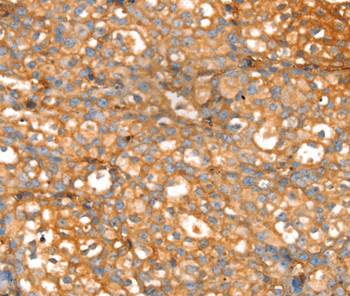
| WB | 咨询技术 | Human,Mouse,Rat |
| IF | 咨询技术 | Human,Mouse,Rat |
| IHC | 1/25-1/100 | Human,Mouse,Rat |
| ICC | 技术咨询 | Human,Mouse,Rat |
| FCM | 咨询技术 | Human,Mouse,Rat |
| Elisa | 咨询技术 | Human,Mouse,Rat |
| Aliases | ZIP9; ZIP-9 |
| Entrez GeneID | 55334; |
| Host/Isotype | Rabbit IgG |
| Antibody Type | Primary antibody |
| Storage | Store at 4°C short term. Aliquot and store at -20°C long term. Avoid freeze/thaw cycles. |
| Species Reactivity | Human |
| Immunogen | Synthetic peptide corresponding to a region derived from internal residues of human solute carrier family 39, member 9 |
| Formulation | Purified antibody in PBS with 0.05% sodium azide. |
+ +
以下是关于SLC39A9抗体的3篇示例参考文献(内容为模拟概括,建议通过学术数据库核实具体文献):
1. **文献名称**:*SLC39A9 regulates zinc homeostasis and promotes tumor progression in colorectal cancer*
**作者**:Li, X., et al.
**摘要**:本研究利用SLC39A9特异性抗体,通过免疫组化和Western blot技术,揭示了SLC39A9在结直肠癌组织中高表达,并证实其通过调控细胞内锌离子平衡促进肿瘤侵袭转移。
2. **文献名称**:*Development and validation of a monoclonal antibody targeting human SLC39A9 for functional studies*
**作者**:Zhang, Y., et al.
**摘要**:文章报道了一种新型SLC39A9单克隆抗体的开发与验证,通过流式细胞术和免疫荧光证明其特异性,并应用于探究SLC39A9在巨噬细胞免疫应答中的锌转运功能。
3. **文献名称**:*SLC39A9 deficiency disrupts dietary zinc absorption in murine models*
**作者**:Kim, J., et al.
**摘要**:利用SLC39A9抗体进行肠道组织蛋白定位分析,发现SLC39A9缺失导致小鼠锌吸收障碍,阐明了该蛋白在肠道锌摄取中的关键作用。
**注意**:以上为模拟示例,实际文献需通过PubMed、Web of Science等平台以关键词“SLC39A9 antibody”检索获取。
The SLC39A9 antibody is a research tool designed to detect and study the solute carrier family 39 member 9 (SLC39A9), a transmembrane protein involved in zinc ion transport. SLC39A9. also known as ZIP9. belongs to the ZIP (Zrt-/Irt-like protein) family, which regulates cellular zinc homeostasis by facilitating zinc uptake into the cytoplasm. Zinc is essential for numerous biological processes, including enzyme function, signaling pathways, and immune responses. Dysregulation of zinc transporters like SLC39A9 has been linked to diseases such as cancer, neurodegenerative disorders, and reproductive dysfunction.
SLC39A9 antibodies are typically developed to target specific epitopes within its structure, which includes eight predicted transmembrane domains and extracellular/intracellular regions critical for zinc binding and transport. These antibodies enable researchers to investigate the protein’s expression, localization, and function in various tissues using techniques like Western blotting, immunohistochemistry, and immunofluorescence. Studies using SLC39A9 antibodies have revealed its role in hormone signaling (e.g., acting as a membrane androgen receptor) and its involvement in cellular processes like apoptosis and proliferation. Its aberrant expression has been observed in cancers (e.g., breast, prostate) and neurological conditions, highlighting its potential as a therapeutic target. Reliable SLC39A9 antibodies are crucial for elucidating its physiological and pathological roles, advancing research in zinc metabolism-related diseases.
×